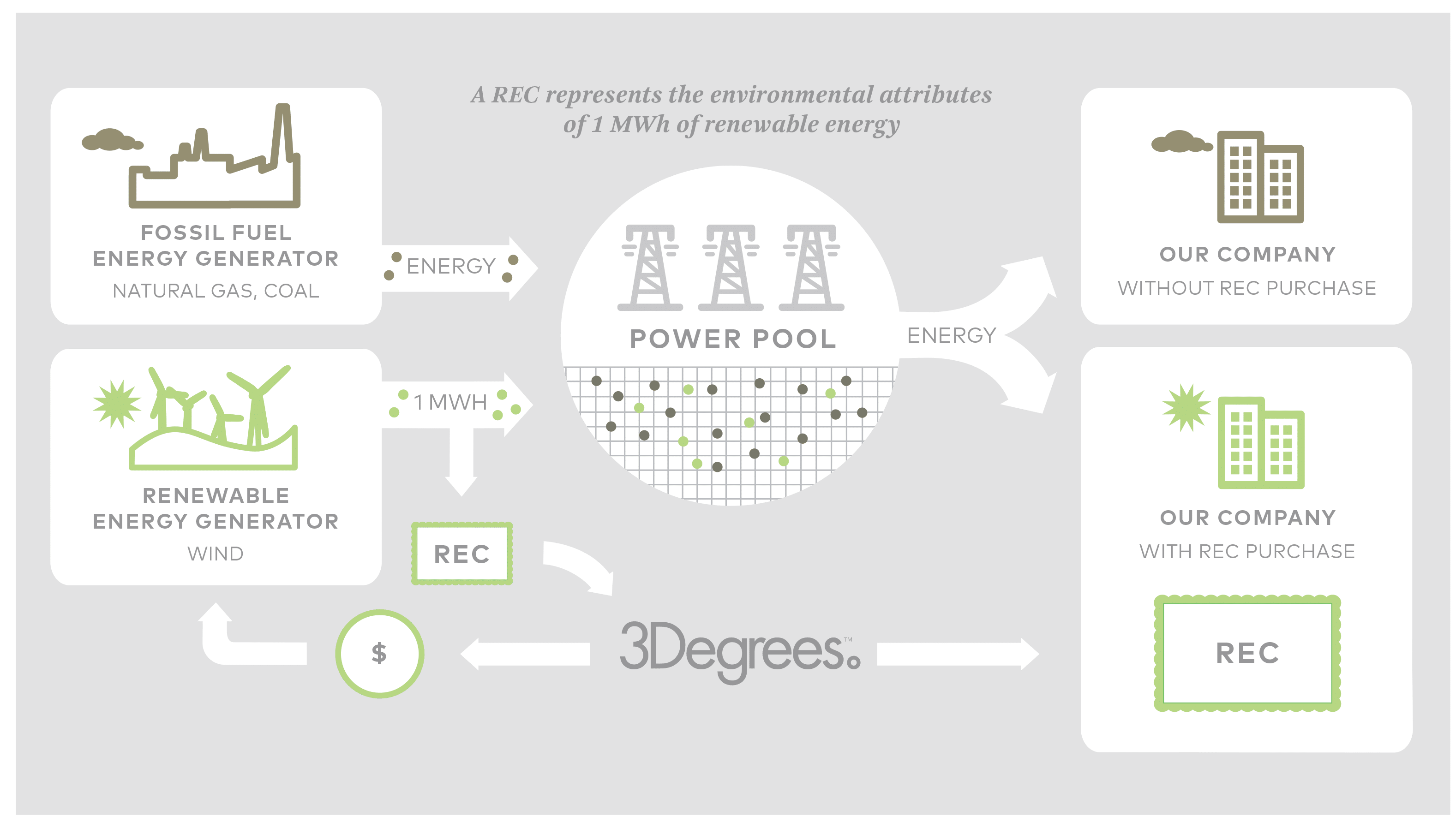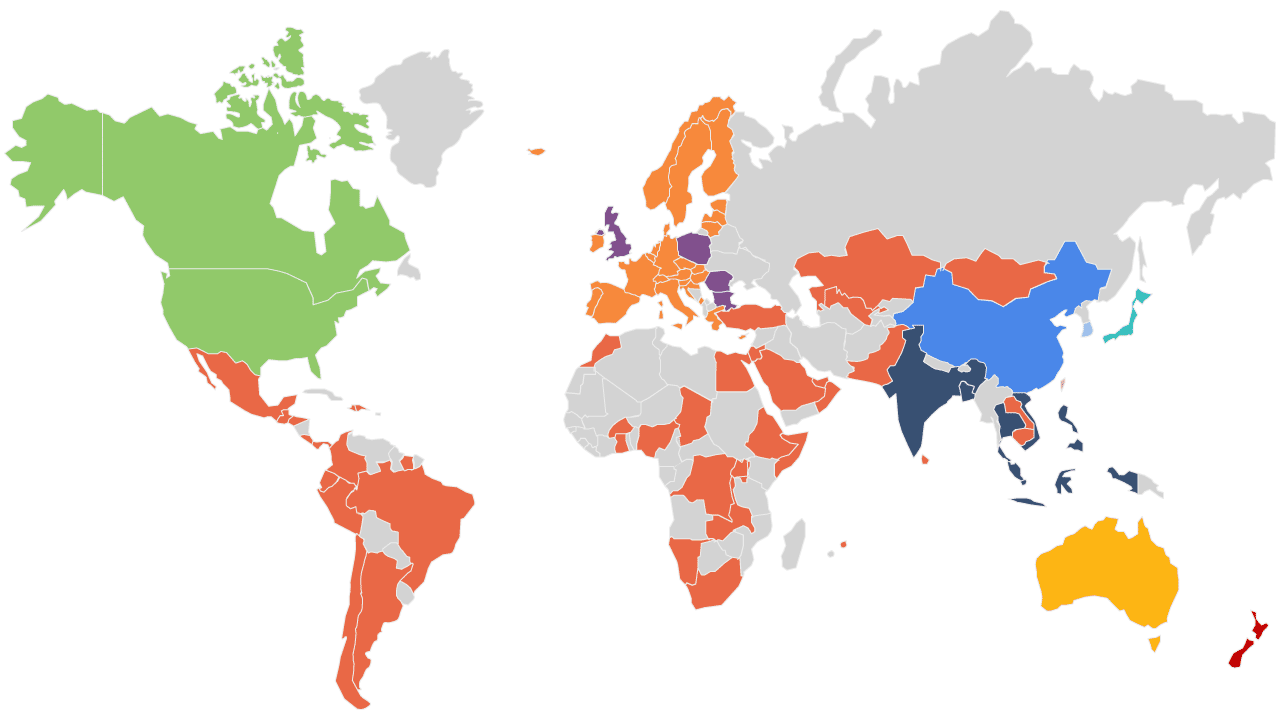|
Interested in more on renewable energy markets? Download our latest report and subscribe to future editions of 3Degrees’ U.S. Market Insights Report to keep track of market trends and their effects on the renewable energy market landscape in the U.S. |
Organizations are increasingly setting ambitious clean energy commitments and goals. Renewable energy certificates (RECs) are a critical tool to help organizations meet those goals.
Normally, when purchasing electricity from the power grid, your energy comes from a mix of sources that emit high carbon emissions, like oil and coal, or low to zero carbon emissions, like solar and wind. The mix depends on factors like location and time of day, but there’s typically no way to discern which power source your electricity is coming from at any point in time. However, organizations (or individuals) can purchase RECs to claim the use of renewable energy from the grid.
“RECs legally convey the attributes of renewable electricity generation, including the emissions profile of that generation, to their owner and serve as the basis for a renewable electricity consumption claim. As such, the REC owner has exclusive rights to characterize the quantity of their purchased electricity associated with the RECs as zero-emissions electricity,” explains the U.S. Environmental Protection Agency (EPA).
In this article, we’ll take a closer look at:
![]() What RECs are;
What RECs are;
![]() The different types of RECs and similar instruments; and
The different types of RECs and similar instruments; and
![]() How to buy RECs to reach your environmental goals.
How to buy RECs to reach your environmental goals.
RECs defined
A REC is a market-based instrument that represents the non-power benefits of one megawatt-hour (MWh) of energy generated from a renewable energy source and delivered to the grid. These non-power benefits, such as the zero-emissions profile of renewable electricity, can only be claimed by the REC holder. RECs allow organizations to claim the use of renewable energy and to reduce their scope 2 emissions, i.e., indirect emissions from their purchased electricity, under the GHG Protocol’s Scope 2 Guidance.
“When electricity is generated, the electrons are all mixed together on the grid, and there is no way to know the sources from which they were generated. RECs make it possible for consumers and businesses to choose clean energy and not have it be claimed by anyone else,” explains the nonprofit Center for Resource Solutions (CRS).
A REC is also sometimes called a renewable energy credit. While RECs and renewable energy credits are generally considered to be interchangeable terms, the more accepted one is renewable energy certificate.
Bundled vs. unbundled RECs
Organizations can purchase RECs combined with the underlying electricity or separately. When the REC and the MWh of electricity are sold together, that’s known as a bundled REC. When the REC is sold separately from the underlying electricity, that’s known as an unbundled REC.
While it’s possible to use a power purchase agreement (PPA) to buy electricity directly from a provider that sells bundled RECs, not everyone has this capability. For one, regulated electricity markets often do not allow for the use of PPAs. An alternative, virtual or financial PPA, can be used in regulated markets, yet these are typically complex financial transactions that carry price risk due to the variability of electricity rates. Instead, purchasing unbundled RECs can enable you to meet renewable energy goals while sticking with your current electricity provider.
Although some organizations are skeptical about the impact of unbundled RECs, these instruments can help support the clean energy transition. By directing funds towards renewable energy projects, an unbundled REC purchase provides a market signal for support of renewable energy development. Even if that energy doesn’t make its way directly to your facilities, you’re still helping to improve the overall mix of renewable vs. fossil fuel energy in an electricity grid.

Types of REC projects
RECs can come from any source of renewable power, but two of the most common are solar energy and wind power projects.
For example, REC projects in 3Degrees’ portfolio include ones like the Armadillo Flats Wind Project, which is a wind farm that operates in Oklahoma. Oil wells once dominated this region, but now it contains a growing wind and renewables industry.
Another one of 3Degrees’ REC projects is Posigen Rooftop Solar, which produces rooftop community solar that, in addition to providing clean energy, has a social co-benefit of providing more resources to an underserved, historically excluded community.
Outside of wind and solar projects, other types of renewable energy projects can include hydropower, biomass, or geothermal projects.
Certification for RECs
While RECs are a legal instrument in many states to account for the environmental benefits of renewable energy, according to CRS, there’s not a unified, governmental body that issues and manages RECs. Instead, different organizations have their own certification programs.
Perhaps the most well-known voluntary REC certification program is Green-e® from CRS.
Green-e®’s certification criteria include that the renewable energy “must be generated from new facilities, marketed with complete transparency and accuracy, and delivered to the purchaser, who has sole title. Green-e® staff verifies the entire chain of custody of certified renewable energy from generation to retirement to ensure individuals and businesses are getting exactly what they paid for,” explains Green-e®.
Not only does buying a REC certified by a program like Green-e® bring confidence in the authenticity of a renewable energy project, but it also helps avoid problems like double-counting emissions benefits. High-quality certification programs ensure that a REC is properly accounted for and retired within a registry after being sold. This way, organizations can feel confident incorporating REC purchases into their scope 2 accounting and meeting other voluntary or compliance goals, like renewable portfolio standards (RPS).
RECs vs. EACs
RECs are used as a way to account for the additional benefits of renewable electricity production in the U.S. and Canada. Around the world, other countries have similar instruments that use different names. All of these instruments fall under the umbrella of energy attribute certificates (EACs).
For example, most of Europe uses what’s known as guarantees of origin (GOs). Like RECs, these represent the emissions intensity of one MWh of energy coming from a particular source, but GOs can apply to both renewable and non-renewable energy sources. However, 3Degrees only provides GOs connected to renewable sources.
Another type of EAC is an international renewable energy certificate (I-REC), which is essentially the same as a REC, but used in more than 50 countries.

| ◉ RECs (Renewable Energy Certificates) ◉ I-REC (I-REC standard certificate) ◉ AIB GO (AIB Guarantee of Origin) ◉ Non-AIB GO or REGO (Non-AIB Guarantee of Origin or Renewable Energy Guarantee of Origin) ◉ NZECS (New Zealand Energy Certificate System) |
◉ I-REC & LGCs (Large-scale Generation Certificates) ◉ TIGRs & I-REC ◉ T-RECs & TIGRs & I-REC ◉ J-Credit & I-REC & NFCs (Non-Fossil Value Certificates) ◉ TIGRS & GECs (Green Electricity Certificates) ◉ TIGRS & Korea RE100 Certificates (REC) |
| ◉ RECs (Renewable Energy Certificates) ◉ I-REC (I-REC standard certificate) ◉ AIB GO (AIB Guarantee of Origin) ◉ Non-AIB GO or REGO (Non-AIB Guarantee of Origin or Renewable Energy Guarantee of Origin) ◉ NZECS (New Zealand Energy Certificate System) ◉ LGCs (Large-scale Generation Certificates) ◉ TIGRs ◉ T-RECs & TIGRs ◉ J-Credit & NFCs (Non-Fossil Value Certificates) ◉ TIGRS & GECs (Green Electricity Certificates) ◉ TIGRS & Korea RE100 Certificates (REC) |
How can you buy RECs?
The energy providers that generate RECs often sell these certificates to REC retailers, such as organizations involved in energy and climate initiatives. If you want to buy Green-e® certified RECs, for example, you can find a list of certified green power providers on their website.
When looking to purchase RECs, it’s important to consider more than just the price and MWh represented. You want to make sure you’re purchasing from a reputable source so that you can confidently make associated renewable energy claims.
You should also consider what went into creating the REC by digging into the renewable energy project details, like looking at the location, technology, project timeline, and co-benefits. For example, you could purchase RECs that also reinvest in the communities where you operate to align better with your ESG strategy.
If you’d like to discuss how buying RECs can help address your electricity emissions and reach your sustainability and compliance goals, please get in touch. 3Degrees is an award-winning seller of renewable energy that can help you figure out how RECs fit into your energy and emissions strategies.
FAQs
Want some quick insights into what renewable energy certificates (RECs) are and why you should consider buying them? Take a look at these FAQs.
How do RECs work?
RECs work by representing the non-power benefits (e.g., emissions intensity) of renewable energy on a shared grid. Each REC represents the emissions of one MWh of renewable electricity generated and sent to the grid.
Sometimes the energy and associated RECs are bundled together, and sometimes the energy and associated RECs are unbundled and sold separately. Either way, purchasing a REC is an acceptable way to make renewable energy use claims, because even if you aren’t directly receiving energy from renewables (considering energy gets mixed within the grid), the REC transfers ownership of the environmental attributes and substantiates the claim of the buyer.
Why purchase RECs?
Buying RECs can be a great way to reduce your scope 2 emissions and provide market-based support for a clean energy system that ultimately contributes to the fight against climate change. If you don’t have the ability to generate clean energy on-site, such as from solar panels, or you’re transitioning your energy plan toward green energy, you can still purchase zero-emission electricity and reach your renewable energy goals by buying RECs.
For more FAQs, see our article on RECs and other global EACs here.
|
Get more insights on renewable energy markets by downloading our latest 3Degrees’ U.S. Market Insights Report and subscribing to future editions. |


